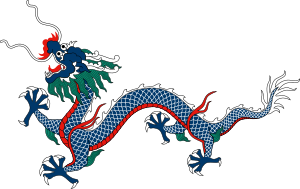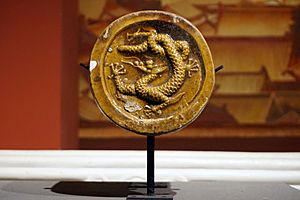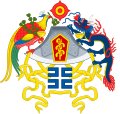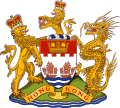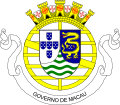Chinese dragon facts for kids
|
The Azure Dragon depicted on the flag of the Qing dynasty
|
|
| Grouping | Mythical creature |
|---|---|
| Sub grouping | Dragon |
| Country | China |
| Chinese dragon | |||||||||||||||||||||||||||||||||||
|---|---|---|---|---|---|---|---|---|---|---|---|---|---|---|---|---|---|---|---|---|---|---|---|---|---|---|---|---|---|---|---|---|---|---|---|

"Dragon" in oracle bone script (top left), bronze script (top right), seal script (middle left), Traditional (middle right), Japanese new-style (shinjitai, bottom left), and Simplified (bottom right) Chinese characters
|
|||||||||||||||||||||||||||||||||||
| Traditional Chinese | 龍 | ||||||||||||||||||||||||||||||||||
| Simplified Chinese | 龙 | ||||||||||||||||||||||||||||||||||
|
|||||||||||||||||||||||||||||||||||
The Chinese dragon, also known as the loong, long or lung (Chinese: 龍 / 龙), is a famous legendary creature in Chinese mythology and Chinese culture. These dragons often look like snakes with four legs, but they can also appear as turtles or fish. Experts believe the idea of Chinese dragons came from things like snakes, Chinese alligators, and even the worship of thunder and nature.
Chinese dragons are usually seen as symbols of powerful and good luck, especially because they control water. The idea of dragons from China has spread to many other Asian countries, like Korea, Vietnam, and Japan. In the past, the dragon was even used as a national symbol for China, like on the "Yellow Dragon flag" of the Qing dynasty. This made many European countries think of China as a dragon. Even today, the white dragon on the flag of modern Bhutan looks like a classic Chinese dragon.
Contents
What Do Chinese Dragons Symbolize?
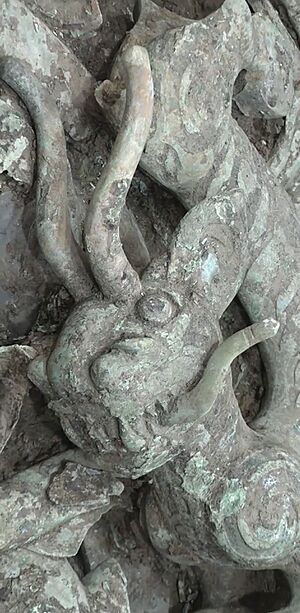
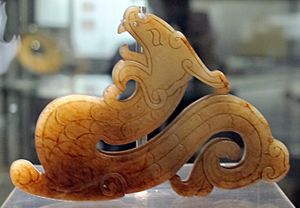
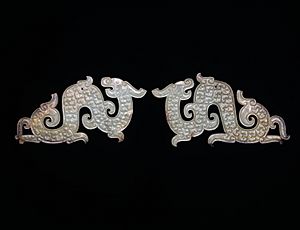
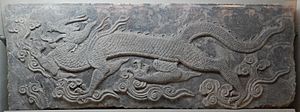
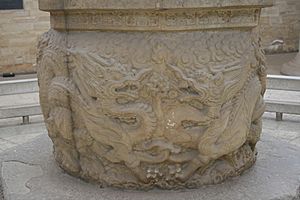
For a long time, the Chinese dragon was a strong symbol for the Emperor of China. It showed the emperor's great power. For example, Liu Bang, who started the Han dynasty, said he was born after his mother dreamed of a dragon.
During the Tang dynasty, emperors wore special robes with dragon designs. Important officials could also receive these dragon robes as gifts. Later, in the Yuan dynasty, only the Emperor could use the five-clawed dragon symbol. Princes and nobles used four-clawed dragons. This rule continued in the Ming and Qing dynasties, where the five-clawed dragon was only for the Emperor. The dragon even appeared on China's first national flag during the Qing dynasty.
The image of the Chinese dragon became clear during the Shang and Zhou dynasties. In the Han Dynasty, a winged dragon called Yinglong became a symbol of imperial power. It was often seen on royal items. Yinglong is an ancient Chinese dragon with wings. Old writings and art show Yinglong had the power to control the sky and was very important.
However, after the Tang and Song Dynasties, the main dragon symbol for the emperor changed. It was no longer the winged Yinglong, but the wingless Yellow Dragon we see today. Some scholars believe that over time, the wings of Yinglong were simplified in art. They turned into flame-like or cloud-like patterns on the dragon's shoulders. Eventually, the wingless Yellow Dragon became the main symbol of imperial power.
In Western countries, the dragon is sometimes used as a symbol for China. But in China itself, it's more often a symbol of culture. In Hong Kong, a dragon was part of the coat of arms when it was under British rule. It's also part of the "Brand Hong Kong" symbol today.
Chinese dragons are very different from European dragons. European dragons often breathe fire and are seen as aggressive. But Chinese dragons are spiritual symbols that bring good luck and wealth. They are also seen as gods of rain who bring harmony. Because of how dragons are seen outside China, the Chinese government decided not to use a dragon as the official mascot for the 2008 Summer Olympics. They chose more "friendly" symbols instead.
Sometimes, Chinese people call themselves "Descendants of the Dragon" (simplified Chinese: 龙的传人; traditional Chinese: 龍的傳人). This shows their ethnic identity. This trend started in the 1970s when many Asian groups looked for animal symbols to represent themselves.
Dragons as State Symbols
The dragon was a symbol for the Chinese emperor for many dynasties. During the Qing dynasty, the Azure Dragon was on China's first national flag. It was also on the Twelve Symbols national emblem, used by the Republic of China from 1913 to 1928.
-
Imperial jade seal, Yuan dynasty (1271–1368)
-
Jade seal, Ming dynasty (1368–1644)
-
State emblem of Republic of China, 1913–1928
The dragon has also been a state symbol in Vietnam. During the Nguyễn dynasty, dragons were on imperial flags. They were also on the coats of arms for the State of Vietnam and later South Vietnam.
-
Imperial standard of emperors Khải Định and Bảo Đại, 1922–1945
Dragon Worship and Beliefs
Where Did Dragon Worship Come From?
Ancient Chinese people sometimes called themselves "the gods of the dragon." This is because the Chinese dragon was seen as a symbol of how their ancestors evolved and of qi energy. Very old dragon-like designs made of stone have been found in China, dating back to 6200–5400 BC.
The idea of dragons in Chinese culture goes back thousands of years. A dragon statue from 5000 BC was found in 1987. Also, jade carvings of coiled dragons have been found from the Hongshan culture (around 4700–2900 BC). Some of the earliest dragon art includes "pig dragon" carvings from the Hongshan culture.
The coiled shape of dragons or snakes was very important in early Chinese culture. The first Chinese writing for "dragon" looked like a coiled shape. Later jade dragon charms from the Shang period also had this coiled form.
Ancient Chinese people thought that dinosaur bones they found were actually dragon bones. They even wrote about finding "dragon bones" in Sichuan around 300 BC. Today, the Chinese word for dinosaur means "terror dragon." People in central China still dig up fossilized "dragon bones" for traditional medicines.
Interestingly, a dinosaur found in China is named Mei long, which means 'sleeping dragon' in Chinese. Its fossils were found in a sleeping, coiled position, with its head tucked under its arm and its tail wrapped around its body.
The Mythical Dragon Creature
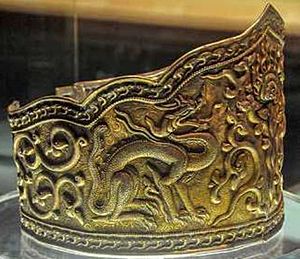
Over time, the Chinese dragon changed from simple animal symbols into a mythical creature. A scholar from the Han dynasty, Wang Fu, wrote about Chinese myths. He said that long dragons had nine parts that looked like other animals.
He wrote that dragons have:
- The antlers of a stag.
- The head of a camel.
- The eyes of a demon.
- The neck of a snake.
- The belly of a clam (called shen).
- The scales of a carp.
- The claws of an eagle.
- The soles of a tiger.
- The ears of a cow.
He also said that a dragon has a special lump on its head called chimu. If a dragon doesn't have this chimu, it cannot fly up to the sky. Other sources give slightly different lists of these nine features.
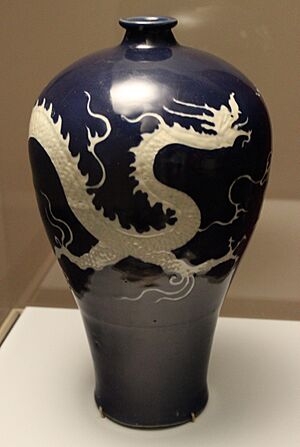
Chinese dragons were thought to be very powerful. They had 117 scales: 81 were positive (yang) and 36 were negative (yin). At first, dragons were seen as kind, wise, and fair. But later, some people believed that certain dragons could be bad. They thought these bad dragons could cause floods, tidal waves, and storms. It was believed that upsetting a dragon could lead to terrible floods.
Many pictures of Chinese dragons show a flaming pearl under their chin or in their claws. This pearl is linked to spiritual energy, wisdom, wealth, power, and even the moon. Chinese art often shows two dragons chasing or fighting over this flaming pearl.
Sometimes, Chinese dragons are shown with bat-like wings on their front legs. But most dragons don't have wings. Their ability to fly and control water is seen as magical, not because of their body parts.
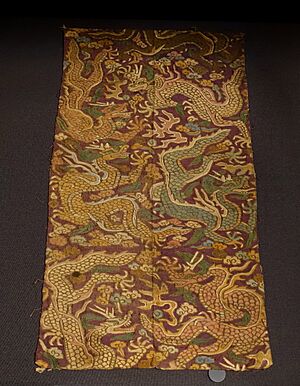
This description matches how dragons are shown in art even today. Dragons are also believed to have many supernatural powers. They can change their size, from as small as a silkworm to as big as the entire universe. They can fly through clouds or hide in water. They can create clouds, turn into water, change colors to blend in, or even glow in the dark.
Some stories say that the dragon has features from all 11 other animals of the Chinese zodiac. This includes the whiskers of the Rat, the face and horns of the Ox, the claws and teeth of the Tiger, the belly of the Rabbit, the body of the Snake, the legs of the Horse, the goatee of the Goat, the wit of the Monkey, the crest of the Rooster, the ears of the Dog, and the snout of the Pig.
It's considered bad luck to show a dragon facing downwards. This is because it looks like the dragon can't fly to the sky. Dragon tattoos are also popular. They symbolize strength and power. Some believe you must be strong enough to "wear" a dragon tattoo, or your luck might be taken by the dragon.
Dragons as Rulers of Weather and Water
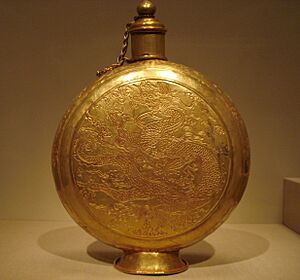
Chinese dragons are strongly connected to water and weather in popular beliefs. They are thought to rule over bodies of water like waterfalls, rivers, and seas. The Dragon God is believed to bring rain and represents the strong, masculine yang power. When shown as rulers of water and weather, dragons often look more human-like. They might be dressed in a king's clothes but have a dragon's head with a king's crown.
There are four main Dragon Kings, each ruling one of the Four Seas:
- The East Sea (like the East China Sea)
- The South Sea (like the South China Sea)
- The West Sea (sometimes seen as Qinghai Lake and beyond)
- The North Sea (sometimes seen as Lake Baikal)
Because of this connection, dragons are seen as being "in charge" of weather related to water. In old times, many Chinese villages, especially those near rivers and seas, had temples for their local "dragon king." If there was a drought or a flood, people would offer sacrifices and perform religious ceremonies. They would ask the dragon for rain or to stop the rain.
Dragons as Symbols of Imperial Power
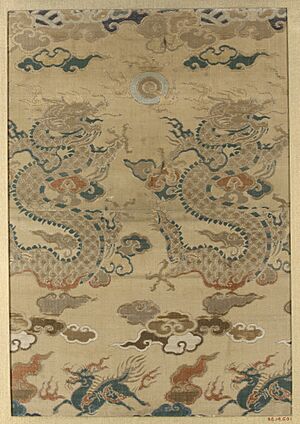
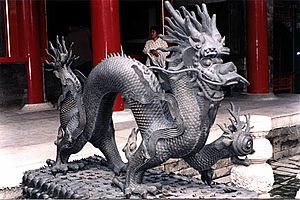
According to Chinese legends, the first Chinese ancestors, Door and the Yellow Emperor (Huangdi), were linked to the Chinese dragon. It is said that at the end of his rule, the Yellow Emperor became an immortal dragon and flew to Heaven. The other legendary ruler, the Yan Emperor, was born after his mother had a special connection with a mythical dragon. Since Chinese people see the Yellow Emperor and Yan Emperor as their ancestors, they sometimes call themselves "the descendants of the dragon." This legend helped make the Chinese dragon a symbol of imperial power.
Dragons, usually with five claws, were a symbol for the emperor in many Chinese dynasties. During the Qing dynasty, the imperial dragon was yellow or gold. In the Ming dynasty, it was red. The emperor's throne was even called the Dragon Throne. In the late Qing dynasty, the dragon was used on the national flag. You can see dragons carved on the stairs and walkways of imperial palaces and tombs, like in the Forbidden City in Beijing.
In some Chinese legends, an emperor might be born with a birthmark shaped like a dragon. For example, one story tells of a peasant with a dragon birthmark who later overthrows the old dynasty and starts a new one. Another story might be about a prince hiding from enemies who is found because of his dragon birthmark.
The Empress of China was often linked to the Chinese phoenix.
Modern Beliefs About Dragons
Worship of the Dragon God is celebrated across China with special offerings and parades. These happen during the fifth and sixth months of the lunar calendar, especially on the Dragon God's birthday, the thirteenth day of the sixth month. In modern Hebei, there's a folk religious group that mainly worships a general Dragon God. They use a tablet with his name on it as his symbol.
How Dragons Are Depicted
Ancient Dragon Depictions

Dragon-like images have been found in many ancient archaeological sites across China. Some of the earliest dragon pictures were found at Xinglongwa culture sites. Clay pots with dragon designs have been found at Yangshao culture sites in Xi'an. A burial site called Xishuipo in Puyang has a large dragon mosaic made from clam shells. The Liangzhu culture also created dragon-like patterns. In Inner Mongolia, Hongshan culture sites have yielded jade dragon objects shaped like "pig dragons." These are the first 3D images of Chinese dragons.
One early form was the pig dragon. It was a coiled, long creature with a head like a boar. The ancient Chinese writing for "dragon" looked similar to this coiled shape. Later jade dragon amulets from the Shang dynasty also had this form. A snake-like dragon painted on red pottery was found at Taosi (Shanxi) from the Longshan Culture. Also, a dragon-like object covered with about 2000 pieces of turquoise and jade was found at Erlitou.
Different Types of Dragons
Chinese stories and myths mention many dragons besides the famous long. A linguist named Michael Carr studied over 100 old dragon names from Chinese texts. Many of these names end with -long:
- Tianlong (Chinese: 天龍; pinyin: tiānlóng; literally "heavenly dragon"): A celestial dragon that guards heavenly palaces and pulls divine chariots. It's also a name for the constellation Draco.
- Shenlong (Chinese: 神龍; pinyin: shénlóng; literally "god dragon"): A thunder god that controls the weather. It has a human head, a dragon's body, and a drum-like stomach.
- Fuzanglong (Chinese: 伏藏龍; pinyin: fúcánglóng; literally "hidden treasure dragon"): An underworld guardian of precious metals and jewels, linked to volcanoes.
- Dilong (Chinese: 地龍; pinyin: dìlóng; literally "earth dragon"): Controls rivers and seas. It's also a name for the earthworm.
- Yinglong (Chinese: 應龍; pinyin: yìnglóng; literally "responding dragon"): A winged dragon linked to rains and floods. The Yellow Emperor used it to defeat Chi You.
- Jiaolong (Chinese: 蛟龍; pinyin: jiāolóng; literally "crocodile dragon"): A dragon with no horns or scales, considered the leader of all water animals.
- Panlong (Chinese: 蟠龍; pinyin: pánlóng; literally "coiled dragon"): A lake dragon that has not yet flown to heaven.
- Huanglong (Chinese: 黃龍; pinyin: huánglóng; literally "yellow dragon"): A hornless dragon that symbolizes the emperor.
- Feilong (Chinese: 飛龍; pinyin: fēilóng; literally "flying dragon"): A winged dragon that rides on clouds and mist. It's also a name for a type of pterosaur.
- Qinglong (Chinese: 青龍; pinyin: qīnglóng; literally "Azure Dragon"): The animal linked to the East in the Chinese Four Symbols.
- Qiulong (Chinese: 虯龍; pinyin: qíulóng; literally "curling dragon"): Can mean either a "horned dragon" or a "hornless dragon."
- Zhulong (Chinese: 燭龍; pinyin: zhúlóng; literally "torch dragon"): A giant red dragon god of the sun. It had a human face and a snake's body. It supposedly created day and night by opening and closing its eyes.
Some Chinese dragon names start with long-:
- Longwang (Chinese: 龍王; pinyin: lóngwáng; literally "Dragon Kings"): Divine rulers of the Four Seas.
- Longma (Chinese: 龍馬; pinyin: lóngmǎ; literally "dragon horse"): A creature that came from the Luo River and showed the ba gua to Fu Xi.
There are also other Chinese dragons not named with long (龍), such as:
- Hong (Chinese: 虹; pinyin: hóng; literally "rainbow"): A two-headed dragon or rainbow serpent.
- Shen (Chinese: 蜃; pinyin: shèn; literally "giant clam"): A shapeshifting dragon or sea monster that is believed to create mirages.
- Bashe (Chinese: 巴蛇; pinyin: bāshé; literally "ba snake"): A giant python-like dragon that ate elephants.
- Teng (Chinese: 螣; pinyin: téng): Or Tengshe (simplified Chinese: 腾蛇; traditional Chinese: 騰蛇; pinyin: téngshé; meaning "soaring snake"), a flying dragon without legs.
Chinese scholars have sorted dragons into different groups. For example, Emperor Huizong of the Song dynasty named five colored dragons as "kings":
- The Azure Dragon (Qinglong 青龍): The most kind kings.
- The Vermilion Dragon (Zhulong 朱龍 or Chilong 赤龍): Kings that bring blessings to lakes.
- The Yellow Dragon (Huanglong 黃龍): Kings that listen to all requests.
- The White Dragon (Bailong 白龍): Virtuous and pure kings.
- The Black Dragon (Xuanlong 玄龍 or Heilong 黑龍): Kings living deep in mysterious waters.
These colored dragons, along with the Yellow Dragon in the center, match the Four Symbols of Chinese constellations: the Vermilion Bird of the South, the White Tiger of the West, and the Black Tortoise of the North.
Dragons were thought to control and represent natural elements like "water, air, earth, fire, light, wind, storm, and electricity." Some dragons that could breathe fire were believed to have been sent away from tiān (heaven) and banished to Earth.
The Nine Sons of the Dragon
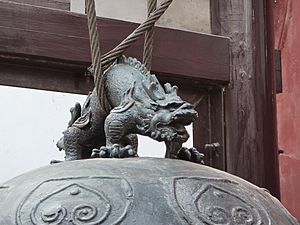
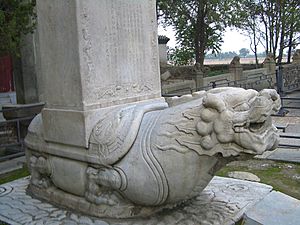
Many Ming dynasty texts list what are called the Nine Offspring of the Dragon (龍生九子). These appear often in popular Chinese stories. A scholar named Xie Zhaozhe (1567–1624) wrote about these nine sons in his work Wu Za Zu (around 1592). Their shapes are used as decorations based on what they like.
Here are some of the dragon's nine children:
- The pú láo (蒲牢): A small dragon that likes to scream. Its image is used on the tops of bells as handles.
- The qiú niú (囚牛): Likes music. Its image is used to decorate musical instruments.
- The chī wěn (蚩吻): Likes swallowing. Its image is placed on both ends of roof ridges to "swallow" bad influences.
- The cháo fēng (嘲風): A beast-like dragon that likes adventure. Its image is placed on the four corners of roofs.
- The yá zì (睚眦): Likes to kill. Its image is carved on sword guards.
- The xì xì (屓屭): Looks like a chī hǔ (a small dragon) and likes literature. Its image is on the sides of grave monuments.
- The bì àn (狴犴): Likes arguments. Its image is placed over prison gates to guard them.
- The suān ní (狻猊): Likes to sit down. Its image is on the bases of Buddhist statues, under the feet of Buddhas or Bodhisattvas.
- The bì xì (贔屭), also known as bà xià (霸下): A large tortoise that likes to carry heavy objects. Its image is placed under grave monuments.
Another poet, Yang Shen (1488–1559), gave different names for the fifth and ninth children:
- The tāo tiè (饕餮): A beast-like creature that loves to eat. Its image is found on food-related items.
- The jiāo tú (椒圖): Looks like a conch or clam. It doesn't like to be bothered and is used on front doors or doorsteps.
There's also bā xià (𧈢𧏡), a mix of a reptile and a dragon that likes to drink water. Its image is often used on bridge structures. The phrase "nine sons of the dragon" is also a Chinese idiom. It means that among brothers, each one has their own good qualities.
Dragon Claws
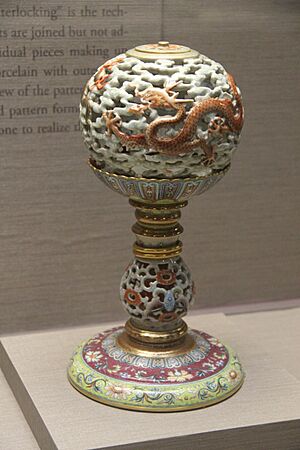
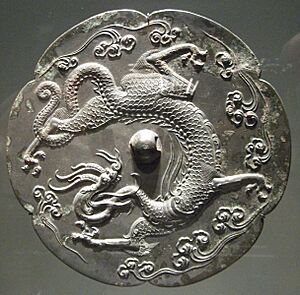
Early Chinese dragons were shown with two to five claws. Different countries that adopted the Chinese dragon have different preferences. In Mongolia and Korea, four-clawed dragons are used. In Japan, three-clawed dragons are common. In China, three-clawed dragons were popular on robes during the Tang dynasty.
During the Yuan dynasty, rules were made about using dragon designs. The five-clawed dragon was only for the emperor. Princes used four-clawed dragons. It was forbidden for common people to wear clothes with certain dragon patterns.
The Hongwu Emperor of the Ming dynasty followed these rules. He declared that the five-clawed dragon would be his symbol. Four-clawed dragons were for imperial nobility and high-ranking officials. Three-clawed dragons were for lower ranks and the general public. However, only the emperor could use a completely gold-colored, five-clawed Long dragon design. Using the wrong number of claws or colors was considered treason. This could lead to the execution of the offender's entire family.
During the Qing dynasty, the Manchus first thought three-clawed dragons were the most sacred. They used them until 1712, when five-clawed dragons became the main symbol. Portraits of Qing emperors usually showed them with five-clawed dragons.
Sometimes, when art pieces left the imperial collection, one claw was removed from each dragon. This was done to avoid breaking the rules about imperial symbols.
Dragons in Other Asian Cultures
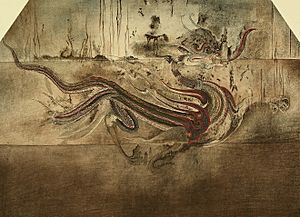
While dragons are shown similarly across cultures, there are some regional differences. Here are some dragons related to the Chinese dragon:
- Druk, the Thunder Dragon from Bhutanese mythology.
- The Japanese dragon.
- The Korean dragon.
- Nāga, a Hindu and Buddhist creature in South Asian and Southeast Asian mythology.
- Bakunawa, a moon-eating sea dragon in Philippine mythology.
- Pakhangba, a Manipuri dragon.
- The Vietnamese dragon.
Here are some dragons similar to the Chinese dragon:
- Makara, a sea dragon in Hindu and Buddhist mythology.
- Yali, a legendary creature in Hindu mythology.
- The Nepalese dragon, sometimes called the "flying snake," shown with Bhairava.
Images for kids
-
The Nine-Dragon Wall in Datong, built in 1392, Ming dynasty
-
Pillar with dragon decoration from the Yingzao Fashi, Song dynasty
-
Dragon column remains, Jin dynasty (1115–1234)
-
Column with dragon design at Temple of Confucius, Qufu, constructed in 1730, Qing dynasty
-
Stone relief of dragons between a flight of stairs in the Forbidden City
-
Dragon symbols on the eaves-tiles of the Forbidden City
-
Emperor Taizong of Tang in dragon robes
-
Dragon images on the borders of Empress Yang's robes, Song dynasty
-
The Hongwu Emperor in a dragon robe, Ming dynasty
-
The Chenghua Emperor in a dragon robe, Ming dynasty
-
The Qianlong Emperor in ceremonial armor decorated with numerous images of dragons, Qing dynasty
-
Ceremonial Qing dynasty armour with dragon imagery, 18th c.
-
Court robe with nine dragons, Qing dynasty
-
Court robe with nine dragons, Qing dynasty
-
Man riding a dragon, Warring States period
-
Azure Dragon of the East, Han dynasty
-
Dragon in a scroll painting, Jin dynasty (1115–1234)
-
Boats with dragon heads, Yuan dynasty, 14th century
-
Cloud Dragon by Anonymous, Ming dynasty, 15th-16th century
-
Constellation deity riding a dragon, Ming dynasty, 16th c.
-
Bronze chariot shaft in the shape of a dragon head, Warring States period
-
Bronze dragon head handle, Han dynasty
-
Gold seal with dragon handle, given to Nanyue by the Han dynasty
-
Lobed mirror, Tang dynasty
-
Gilt gold dragon, Tang dynasty
-
Dragon and phoenix crowns, Liao dynasty
-
Bronze sitting dragon, Jin dynasty (1115-1234)
-
Jade cloud dragon, Warring States period
-
Jade belt clasp, Northern and Southern dynasties period
-
Jade belt plaque, Yuan dynasty
-
Jade belt plaque, Ming dynasty
-
Jade belt plaque, Ming dynasty
-
Pot with black dragon design, Song dynasty
-
Dragon on blue and white vase from the Yuan dynasty (1271-1368), Jingdezhen, unearthed in Jiangxi Province.
-
Lidded jar with yellow dragon, Ming dynasty
-
Blue-and-white porcelain plate with a dragon, Ming dynasty
-
Cup depicting a seaside dragon, Ming dynasty
-
Plate with two dragons, Qing dynasty
-
Bowl with red dragon, Qing dynasty
-
Porcelain jar depicting a red dragon, Qing dynasty
-
Ziwei Chenheng, an armillary sphere with dragons holding it up
-
Non-Imperial Chinese dragon in Shanghai
See also
 In Spanish: Dragón chino para niños
In Spanish: Dragón chino para niños
- An Instinct for Dragons, a theory about where dragon myths come from.
- Chinese alligator
- Chinese mythology
- Fish in Chinese mythology
- Lei Chen-Tzu
- List of dragons in mythology and folklore
- List of dragons in popular culture
- Long Mu (Dragon's Mother)
- Radical 212
- Snakes in Chinese mythology, mostly about less dragon-like types
- China Dragon – a hockey team playing in the Asia League Ice Hockey


